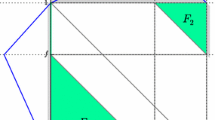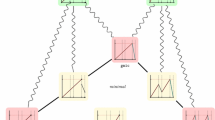Abstract
For the one dimensional infinite group relaxation, we construct a sequence of extreme valid functions that are piecewise linear and such that for every natural number \(k\ge 2\), there is a function in the sequence with k slopes. This settles an open question in this area regarding a universal bound on the number of slopes for extreme functions. The function which is the pointwise limit of this sequence is an extreme valid function that is continuous and has an infinite number of slopes. This provides a new and more refined counterexample to an old conjecture of Gomory and Johnson stating that all extreme functions are piecewise linear. These constructions are extended to obtain functions for the higher dimensional group problems via the sequential-merge operation of Dey and Richard.

Similar content being viewed by others
Notes
The definition of facet used in [9] is slightly different from our definition, and corresponds to what the authors in [4] refer to as weak facet. However, the proof in [9] works for the definition of facet used in this current manuscript. Moreover, we insist on f, g to be minimal valid functions, whereas Dey and Richard consider valid functions that are periodic modulo \(\mathbb {Z}^n\), which is a slightly weaker hypothesis than minimality.
References
Basu, A., Conforti, M., Cornuéjols, G., Zambelli, G.: A counterexample to a conjecture of Gomory and Johnson. Math. Program. Ser. A 133, 25–38 (2012)
Basu, A., Conforti, M., Di Summa, M.: A geometric approach to cut-generating functions. Math. Progr. 151(1), 153–189 (2015)
Basu, A., Hildebrand, R., Köppe, M.: Equivariant perturbation in Gomory and Johnson’s infinite group problem. III. Foundations for the \(k\)-dimensional case and applications to \(k=2\). eprint arXiv:1403.4628 [math.OC], (2014)
Basu, A., Hildebrand, R., Köppe, M.: Light on the infinite group relaxation I: foundations and taxonomy. 4OR 14(1), 1–40 (2016)
Basu, A., Hildebrand, R., Köppe, M.: Light on the infinite group relaxation II: sufficient conditions for extremality, sequences, and algorithms. 4OR 14(2), 1–25 (2016)
Basu, A., Hildebrand, R., Köppe, M., Molinaro, M.: A \((k+1)\)-slope theorem for the \(k\)-dimensional infinite group relaxation. SIAM J. Optim. 23(2), 1021–1040 (2013)
Dey, S.S., Richard, J.-P.P.: Facets of two-dimensional infinite group problems. Math. Oper. Res. 33(1), 140–166 (2008)
Dey, S.S., Richard, J-P.P.: Gomory functions, Personal communication (2009)
Dey, S.S., Richard, J.-P.P.: Relations between facets of low- and high-dimensional group problems. Math. Progr. 123(2), 285–313 (2010)
Dey, S.S., Richard, J.-P.P., Li, Y., Miller, L.A.: On the extreme inequalities of infinite group problems. Math. Progr. 121(1), 145–170 (2009)
Gomory, R.E., Johnson, E.L.: Some continuous functions related to corner polyhedra. I. Math. Progr. 3, 23–85 (1972)
Gomory, R.E., Johnson, E.L.: Some continuous functions related to corner polyhedra. II. Math. Progr. 3, 359–389 (1972)
Gomory, R.E., Johnson, E.L.: T-space and cutting planes. Math. Progr. 96, 341–375 (2003)
Gomory, R.E., Johnson, E.L., Evans, L.: Corner polyhedra and their connection with cutting planes. Math. Progr. Ser. B 96, 321–339 (2002)
Hong, C.Y., Köppe, Matthias, Zhou, Y.: Sage program for computation and experimentation with the 1-dimensional gomory–johnson infinite group problem. available from https://github.com/mkoeppe/infinite-group-relaxation-code., (2012)
Johnson, E.L.: On the group problem for mixed integer programming. Math. Progr. Study 2, 137–179 (1974)
Köppe, M., Zhou, Y.: New computer-based search strategies for extreme functions of the Gomory–Johnson infinite group problem. Math. Progr. Comput. (2016). doi:10.1007/s12532-016-0115-9
Köppe, M., Zhou, Y.: On the notions of facets, weak facets, and extreme functions of the Gomory–Johnson infinite group problem. arXiv preprint arXiv:1611.06626 (2016)
Richard, J.-P.P., Dey, S.S.: The group-theoretic approach in mixed integer programming. In: Jünger, M., Liebling, T.M., Naddef, D., Nemhauser, G.L., Pulleyblank, William R., Reinelt, Gerhard, Rinaldi, Giovanni, Wolsey, Laurence A. (eds.) 50 Years of Integer Programming 1958–2008, pp. 727–801. Springer, Berlin Heidelberg (2010)
Acknowledgements
We would like to thank Santanu Dey for very helpful discussions about the sequential-merge operation. We are also grateful to an anonymous reviewer for very insightful comments, which helped to shorten many proofs and catch errors in a previous draft.
Author information
Authors and Affiliations
Corresponding author
Additional information
Amitabh Basu and Joseph Paat were supported by the NSF Grant CMMI1452820. Michele Conforti and Marco Di Summa were supported by the grant “Progetto di Ateneo 2013” of the University of Padova.
A Appendix
A Appendix
Theorem 8
Let \(n\ge 1\) be a natural number. A function \({ \theta }:\mathbb {R}^n\rightarrow \mathbb {R}_+\) is minimal/extreme/facet for \(I_b\) when \(b\in [0,1/2]^n{\setminus }\{0\}\) if and only if \({ \tilde{\theta }}:\mathbb {R}^n\rightarrow \mathbb {R}_+\) defined by \({ \tilde{\theta }}(x) := { \theta }(-x)\) is minimal/extreme/facet for \(I_{\mathbf {1}-b}\), respectively, where \(\mathbf {1}\in \mathbb {R}^n\) is the vector of all ones.
Proof
The result essentially follows by applying Theorem 8.2 in [16]. However, since that paper considers the so-called mixed-integer problem, while we are looking at the pure integer problem, we include a proof for completeness.
We show one direction as the other follows from swapping the roles of b and \(\mathbf {1}-b\). Suppose that \({ \theta }\) is minimal for \(I_b\) with \(b\in [0,1/2]^n{\setminus }\{0\}\). Define \({ \tilde{\theta }}(x):= { \theta }(-x)\). We check that \({ \tilde{\theta }}\) is minimal using Theorem 1. If \(w\in \mathbb {Z}^n\) then so is \(-w\), and therefore \({ \tilde{\theta }}(w) = { \theta }(-w) = 0\) since \({ \theta }\) is minimal. Let \(x, y\in \mathbb {R}^n\) and note that
where the inequality follows from the subadditivity of \({ \theta }\). Hence \({ \tilde{\theta }}\) is subadditive. Finally, let \(r\in \mathbb {R}^n\) and note that
where the second equation follows from the periodicity of \({ \theta }\) and the third equation from the symmetry of \({ \theta }\). Hence \({ \tilde{\theta }}\) is symmetric about \(\mathbf {1}-b\). From Theorem 1, \({ \tilde{\theta }}\) is minimal.
Now assume that \({ \theta }\) is extreme. Let \(\theta _1, \theta _2\) be valid for \(I_{\mathbf {1}-b}\) such that \({ \tilde{\theta }} = \frac{\theta _1+\theta _2}{2}\). We claim that \(\tilde{\theta }_i(r):=\theta _i(-r)\), \(i=1,2\), is a valid function for \(I_b\). This would imply \({ \tilde{\theta }} = \theta _1=\theta _2\) from the extremality of \({ \theta }\). Let \(y\in I_b\). Then \(\tilde{y}(r) := y(-r)\in I_{\mathbf {1}-b}\). Note that for \(i=1,2\),
since \(\theta _i\) is valid for \(I_{\mathbf {1}-b}\).
The proof that \({ \theta }\) is a facet if and only if \({ \tilde{\theta }}\) is a facet is similar. \(\square \)
Proof
We prove this using induction on k. For \(k=2\), the result is easily verified using (3). So let \(k\ge 3\) and assume that \(\pi _{k-1}\) is well-defined, nonnegative, and positive on \(\mathbb {R}{\setminus } \mathbb {Z}\). First, we will show that \(\pi _k\) is well-defined at the points \(\{b\left( \frac{1}{8}\right) ^{k-2}, 2b(\frac{1}{8})^{k-2}, b-2b(\frac{1}{8})^{k-2}, b-b(\frac{1}{8})^{k-2}, b\}\), that is, we will show \(\pi _k\) is well-defined at the boundaries of the intervals on which it is defined. This will show that \(\pi _k\) is well-defined on [0, 1), and since \(\pi _k\) is periodic by definition, it will follow that \(\pi _k\) is well-defined everywhere.
Note that
where the inequality follows since \(k\ge 3\) and \(b\in (0,1)\). Also, observe that
where the inequalities follow since \(b\in (0,\frac{1}{2}]\) and \(k\ge 3\). Equations (5) and (6) show that \(\pi _k\) is well-defined and positive at the points \(b\left( \frac{1}{8}\right) ^{k-2}\) and \(b-b\left( \frac{1}{8}\right) ^{k-2}\).
Observe that \(b\in I^j_5\cap I^j_6\). Since \(\frac{1-2^{k-2}}{1-b}+\left( \frac{2^{k-2}-b}{b-b^2}\right) b = 1\), it follows that \(\pi _k\) is well-defined and positive at b.
Notice that \(2b\left( \frac{1}{8}\right) ^{k-2}\in I^k_2\subseteq I^{k-1}_1\) by definition. Similarly, \(b-2b\left( \frac{1}{8}\right) ^{k-2}\in I^k_4\subseteq I^{k-1}_5\). Therefore, by induction,
and
where the inequalities follows since \(\pi _{k-1}\) is nonnegative. Thus, \(\pi _k\) is well-defined and positive on \(2b(\frac{1}{8})^{k-2}\) and \(b-2b(\frac{1}{8})^{k-2}\).
Continuity of \(\pi _k\) follows from the recursive piecewise definition and the confirmation above that the values are well-defined on the boundaries of the pieces.
We now show that \(\pi _k\) is nonnegative and \(\pi _k(x)=0\) if and only if \(x\in \mathbb {Z}\). Let \(x\in [0,1)\). If \(x\in I^k_3\cup I^k_6\), then \(\pi _k(x) = \pi _{k-1}(x)> 0\) by the induction hypothesis. Observe that \(\pi _k\) is affine on the intervals \(I^k_1, I^k_2, I^k_4,\) and \(I^k_5\). From Equations (5)-(8), \(\pi _k\) is positive on the endpoints of each of the latter intervals, except for when \(x=0\). Thus, if \(x\in I^k_1{\setminus } \{0\}\cup I^k_2\cup I^k_4\cup I^k_5\), then \(\pi _k(x)> 0\) and \(\pi _k(0)=0\). Finally, if \(x\in \mathbb {R}{\setminus } [0,1)\), then by the periodicity of \(\pi _k\), it follows that \(\pi _k(x)> 0\) and \(\pi _k(x)=0\) if \(x\in \mathbb {Z}\).\(\square \)
Rights and permissions
About this article
Cite this article
Basu, A., Conforti, M., Di Summa, M. et al. Extreme functions with an arbitrary number of slopes. Math. Program. 172, 303–327 (2018). https://doi.org/10.1007/s10107-017-1184-x
Received:
Accepted:
Published:
Issue Date:
DOI: https://doi.org/10.1007/s10107-017-1184-x




